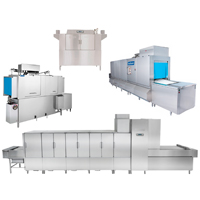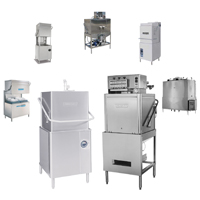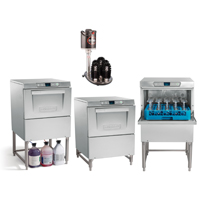Dishwashers
-
Conveyor Dishwashers & Flight Type Dishwashers

-
Single Rack Dishwashers & Double Rack Dishwashers

-
Undercounter Dishwasher

-
Glass Washers

Restaurant Dishwashers
Call us 1.866.618.4999 and let us design the most efficient dish room, free of charge in 30 minutes or less!
If you want to see how your dish room and dish washing station can be set up in the most efficient way possible than contact us. We have designers on standby that can talk to you about how to eliminate bottle necks, optimize your dishroom orginzation and also how to get the most efficiency out of the dish washing equipment investment.
How To Design An Efficient Dish Room
When designing a restaurant for maximum efficiency, every detail matters. This is especially true for the dish room because for a restaurant to be efficient, dishes must be cleaned quickly and thoroughly. If a dish room is not specified with the proper equipment and layout, you will either lose customers or lose money to labor costs. The average employee at any company costs around $38,000 to hire and train. Restaurants cannot afford either of these costly errors.

A kitchen is all about timing. Whoever is operating a dish room has to always be on top of their game. You cannot cook or serve food if your pans and plates aren’t clean. An efficient dish room has two separate processes. One process is to clean dishware, glassware and flatware. The second process is to clean pots and pans. When cleaning dishware, glassware, and flatware, the dishes must be organized, scrapped, and washed. During the washing process, our dish machine will also rinse and sanitize the dishes. To organize dirty dishes, we need a landing table. The landing table is for employees to place dirty dishes after bussing the tables.
Our landing table must be large enough to support a dish decoy system during high-volume peak hours. Dish decoy systems are implemented to sort the soiled dishes as soon as they reach the dish room eliminating confusion and delay. In a decoy system, each type of dish is assigned a particular section on the landing table. When employees bring dirty dishes to the landing table, they will stack like dishes on top of each other.
A large trash bin must be placed underneath the landing table so that employees can pre-scrap dishes before stacking them in the decoy system. The dishes do not need to be scrapped completely, but large food debris will make dish stacking difficult and off balance. Your decoy system must also include a tub of pre-rinse soak solution for soaking utensils. Soaking the utensils makes it much easier to clean off stubborn food debris.
The landing table must also be equipped with a dish sorting over-shelf to support dish racks as they are being loaded. Since employees will be handling dirty dishes in this area, a hand sink also must be placed near the landing table. To increase the sanitary profile of this area, a touch-less hand sink is preferred.
After your dishes are organized and stacked on the landing table, they will need to be scrapped completely before being loaded into the dish machine. An important thing to remember is that you can only wash dishes as fast as you can scrap dishes. Many restaurants use an employee operating a pre-rinse or fresh water trough to scrap dishes. A pre-rinse is not efficient for restaurants using a heavy-duty dish machine (CL-44). The problem with using a pre-rinse with a heavy-duty dish machine is that the operator must have one hand on the spray valve during use. This is not efficient because the average heavy-duty commercial dish machine can wash up to 252 racks per hour (3000 dishes p/h), while the employee using a pre-rinse can only scrap up to 800 dishes per hour at best. Since you can only wash dishes as fast as you can scrap dishes, a bottleneck will form at the pre-rinse station. A fresh water trough is also not efficient because its operating costs are too high. Fresh water troughs do not circulate the water, causing water and sewage costs to skyrocket. In most cases, fresh water troughs also require more employees to operate, increasing your labor costs. For restaurants using a heavy-duty dish machine, the most efficient way to scrap dishes is with a ScrapMaster from Salvajor. The ScrapMaster uses a large plume of circulated water hands-free, allowing the operator to scrap and pre-rinse with both hands as opposed to only using one. Allowing the operator to scrap with both hands will double if not triple the speed of scrapping in comparison to a pre-rinse spray. The ScrapMaster also has a disposal system built into the unit, allowing the operator to scrap even faster. This increased efficiency will eliminate at least one employee from the dish room. Remember the $38,000 we talked about? With that kind of savings, a ScrapMaster can pay for itself in about 4 months. For restaurants with a capacity of 100 people or less, a medium duty high heat dish machine (AM15) is a good option. A pre-rinse can work efficiently in these smaller applications as well. A typical restaurant patron is likely to order a tea, a glass of water, an appetizer, a salad, an entrée, one side, and desert. Therefore, we can expect each customer to use 7 dishware items not including utensils. If you operate a 100-person restaurant, your restaurant can expect 1400 dirty dishes per hour during peak hours. Your dish room employee operating a pre-rinse will be able to handle this load.
After scrapping dishes, the scrapped dishes are place into dishracks which are then placed in the dish machine. Dishracks come in different styles for different dishware types. Some different rack types include glass racks, pegged rack for plates and bowls, and open racks and sheet pan racks. Generally, a common dish-rack will hold 25 dishes. When choosing a dish machine, the most important thing to consider is the water temperature during the final rinse. The water must be at least 180 during the final rinse so that the machine can sanitize without the use of chemicals. The alternative to high temp dish machines are low temp dish machines. Since low temp dish machines use water that is 120-140 degrees, low temp dish machines rely on the use of sanitation and drying chemicals. Chemicals negatively affect the flavor of the food and the taste of drinks. The chemical taste will cause you to lose costumers every day. When serving draft beer, the chemicals react to the draft beer causing the beer to foam. This foam overflow goes right down the drain causing you to lose 40% of your product yield. A high temp dish machine will require a condensate hood to expel the steam but is worth every penny of it.
The high-temp dish machine must be connected to a clean dish table where clean dishes will exit the dish machine. A clean dish table is a table that will accept the clean dish racks and be of enough length to hold up to four (4) racks, giving the dishes enough time to air-dry before they are stored away to be reused again. Wall mounted dish rack-shelves placed above the clean dish table is another option to store your dish-racks keeping them off the floor for sanitation and safety purposes. At the foot of the dish machine, a floor trough drain must be installed. Standing water is the enemy in any part of a restaurant, this includes the dish room. Standing water is a potential safety hazard due to slipping and it could also allow for organisms and insects to fester causing health concerns. Not to mention that if a water line were to burst in the dish room, it would minimize the flooding of the kitchen or dining room. The water would have a place to safely drain until the problem is fixed.
A floor trough should also be placed in front of the three-compartment sink. Since a three-compartment sink is mandatory in any commercial kitchen, it makes all the sense in the world to choose the most efficient three compartment sink possible. The Power Soak three compartment sink is the most efficient option for your dish room. Power Soak provides the power to tackle even the toughest baked-on food soils with minimal scrubbing. Power soak uses jets that continuously circulate warm, soapy water. This agitation caused by the moving water breaks down and weakens food debris, allowing your employees to spend less time scrubbing and more time doing other important tasks. For light food debris, the Power Soak typically washes pots and pans in three to five minutes. Heavily soiled items may take up to fifteen minutes. Just to recap, increasing the efficiency of your dish room will not only save tens-of-thousands of dollars annually, it will also help keep your customers which is priceless. These benefits more than justify the initial investment to implement these systems and design. Thank you.
Your dishwasher is just as important as any other piece of machinery in the kitchen. Without the right dishwasher you could slow down recovery time of soiled dishes, thus slowing serving times.
Whatever your dishwasher need is, we will help you find the one that is right for your kitchen. Whether you need an upright dishwasher, under-counter dishwasher, countertop dish washer, low or high temp dishwasher, we have what you need!


